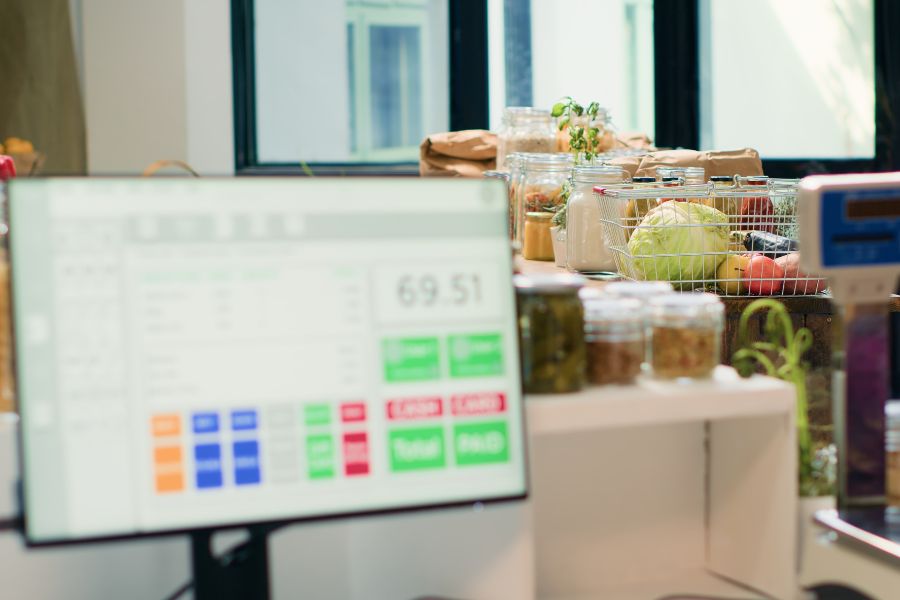A Point of Sale (POS) system is the central hub where retail transactions occur, enabling businesses to process sales, manage inventory, and analyze customer data. Traditionally, POS systems were standalone setups comprising cash registers and basic software. However, in 2025, modern POS solutions like ConnectPOS have evolved into comprehensive, cloud-based platforms that seamlessly integrate online and offline sales channels.
What Is a POS System?
A POS, or point of sale, enables merchants to process payments and log transactions. It is a computer-based cash register with software capable of tallying up orders, taking payments, monitoring inventory and buying trends, creating invoices, and collecting marketing data.
POS technology includes countertop terminals and apps that let people or businesses take payments with connected devices such as smartphones. A POS may be a physical device in a brick-and-mortar store or a checkout point in a web-based store.
A POS system combines hardware and software to facilitate the completion of sales transactions. It allows businesses to:
- Process payments (cash, credit/debit cards, digital wallets)
- Track and manage inventory in real-time
- Generate sales reports and analytics
- Manage customer information and loyalty programs
- Integrate with e-commerce platforms for unified operations
Modern POS systems are designed to enhance efficiency, accuracy, and customer satisfaction across various retail environments.
How Point-of-Sale (POS) Technology Works in Modern Retail
Point-of-sale (POS) systems are central to modern retail, handling everything from transaction processing to inventory tracking. By incorporating technologies like barcode scanning, EMV chips, and NFC, POS platforms streamline operations and enhance payment security both in-store and online.
The Role of Barcode Scanning
POS technology typically uses barcode scanning to:
- Instantly retrieve item details such as name, price, and stock-keeping unit (SKU)
- Calculate the total cost of a customer’s order
- Log itemized transactions for recordkeeping and reporting
Barcode scanning not only speeds up the checkout process but also ensures pricing accuracy and efficient inventory updates.
Payment Processing Methods
POS systems support multiple payment options to cater to customer preferences:
- Cash Payments: Customers pay with coins or notes, which are recorded in the POS system manually or via cash drawers.
- Card Payments: For credit and debit cards, the customer swipes, inserts (chip), or taps their card. The POS system then:
- Connects with the cardholder’s bank
- Authenticates the transaction (sometimes requiring a PIN or biometric)
- Approves or rejects the payment based on available funds
- Contactless Payments & Mobile Wallets: Consumers use smartphones or wearable devices to tap and pay via apps like Apple Pay or Google Wallet. These rely on Near Field Communication (NFC) for fast, touch-free transactions.
Security Technologies: EMV & NFC
Two major innovations have elevated payment security:
- EMV Chip Technology: Reads encrypted data from chip-enabled cards and helps detect counterfeit or cloned cards, reducing the risk of fraud.
- NFC (Near Field Communication): Enables secure, wireless transactions via smartphones or contactless cards. Sensitive card information isn’t stored on the merchant’s system, helping protect customer data.
POS in E-commerce
E-commerce businesses also utilize POS platforms to manage online sales:
- Customers proceed to checkout on a website
- Input card or digital wallet information
- The system processes payments and updates order records in real time
A cloud-based solution like ConnectPOS ensures seamless integration between online and offline channels, supporting omnichannel operations and syncing data across physical stores and e-commerce platforms.
Top Benefits of POS Software for Modern Retailers
Point-of-sale (POS) software plays a critical role in streamlining retail operations by automating transactions and offering real-time insights into business performance. More than just a digital cash register, today’s POS systems combine hardware and software to optimize everything from sales tracking to inventory management.
Automation of Retail Processes
Electronic POS systems automate essential functions like:
- Sales processing
- Payment handling (cash, card, mobile)
- Receipt generation This automation reduces manual errors, speeds up the checkout process, and improves the overall customer experience.
Real-Time Sales Tracking and Reporting
POS software provides up-to-date sales data and customizable reports, enabling retailers to:
- Monitor daily revenue
- Track peak sales hours
- Identify best-selling products This visibility helps owners make informed decisions and plan ahead with confidence.
Inventory Management Made Easy
Advanced POS systems with integrated inventory features allow businesses to:
- Track stock levels in real time
- Receive alerts for low stock
- Monitor inventory turnover This prevents out-of-stock situations and overstocking, both of which can hurt profits and customer satisfaction.
Pricing Accuracy and Error Reduction
With barcode scanning and real-time pricing updates, POS software helps:
- Eliminate manual price entry errors
- Ensure consistent pricing across locations
- Adjust discounts and promotions automatically
Detect and Prevent Losses
POS software tracks every transaction, making it easier to:
- Spot discrepancies or potential fraud
- Analyze cash flow
- Identify employee errors or theft Retailers can minimize shrinkage and maintain tighter control over financial performance.
Customer-Centric Insights
By analyzing sales data and purchasing behavior, POS systems enable retailers to:
- Personalize marketing campaigns
- Offer targeted promotions
- Improve product selection based on customer trends
Bonus: Integration with Other Business Tools
Many modern POS platforms like ConnectPOS integrate seamlessly with:
- Accounting software
- CRM systems
- E-commerce platforms This unification helps retailers manage both front-end sales and back-office operations more effectively.
Marketing and Innovation in POS Technology
While consumers typically encounter point-of-sale (POS) terminals during checkout, the power of POS systems extends far beyond simple transactions. For retailers and marketers alike, POS locations represent a golden opportunity to influence purchasing behavior and create a more personalized customer journey.
POS as a Marketing Tool
Retailers strategically position eye-catching, high-margin products near POS terminals to trigger impulse purchases. Items near checkout counters are typically:
- Visually appealing
- Low-cost or convenient
- Quick to grab without deep consideration
This practice not only boosts average order value (AOV) but also enhances the overall customer shopping experience.
Smart Placement of POS Terminals
Modern stores leverage multiple POS locations across their layout. For example:
- Department stores may use separate POS terminals in different sections like electronics, home goods, or apparel.
- Retailers benefit from micro-marketing, promoting targeted product categories at specific locations to reach buyers at earlier points in the decision-making funnel.
Loyalty and Membership Programs
Many cloud-based POS systems today, including ConnectPOS, allow retailers to build and manage customer loyalty programs, such as:
- Reward points for repeat purchases
- Personalized discounts and offers
- Membership tiers for VIP shoppers
These programs not only foster brand loyalty but also drive repeat business.
Cloud-Based Innovation
Cloud-based POS platforms like ConnectPOS are revolutionizing how businesses operate by:
- Reducing upfront hardware and maintenance costs
- Allowing real-time data synchronization across multiple store locations
- Enabling mobile checkout and on-the-go transactions, especially beneficial for pop-up stores, events, and outdoor markets
What Was the First Point of Sale (POS) System?
The first point of sale (POS) system was the cash register invented in 1879 by James Ritty, a saloon owner in Ohio. Users recorded transactions on the register, allowing for better bookkeeping and capital management. Ritty sold his invention to National Cash Register (NCR) Corporation five years later.8
How Do Retailers Help Prevent Fraud at POS?
Businesses commonly require customer verification. In-store debit card purchases usually require customers to input a PIN. Online or telephone orders commonly require customers to input the CVV code on the back of their payment card.
How Can Consumers Report POS Fraud Suspicions?
The Federal Trade Commission’s Consumer Sentinel Network website is a database that receives reports directly from consumers, federal, state, and local law enforcement agencies, the Better Business Bureau, industry members, and non-profit organizations.
Conclusion
In today’s dynamic retail landscape, a robust POS system is essential for operational efficiency and customer satisfaction. ConnectPOS stands out as a comprehensive solution that not only handles transactions but also integrates various aspects of retail management into a single, cohesive platform. By leveraging ConnectPOS, businesses can enhance their operational capabilities, provide superior customer experiences, and drive growth in an increasingly competitive market.



